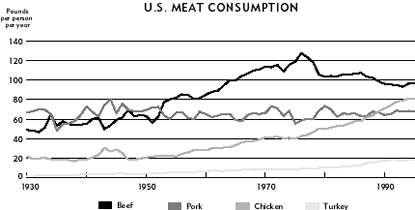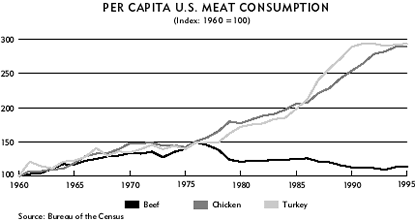Turkey production exemplifies the changes that have taken place in the general poultry sector over the past half century. It has undergone the greatest degree of industrialization and concentration, the greatest increases in efficiency and the highest degree of product development. Moreover, it has overcome a barrier that neither chicken meat nor egg production faced—the identity as a specialty, seasonal food.
The turkey is a quintessential American bird. Indeed, Benjamin Franklin argued that it should be the symbol of the new United States of America rather than the eagle. It was not known in Europe; Charles Dickens and Arthur Conan Doyle, well-known chroniclers of 19th century British life, feature geese in their stories with never a mention of turkey. The turkey entered Western diets only after Europeans settled in New England. Even today, elementary students learn how the Plymouth Bay colonists celebrated their survival and their first summer's crops by feasting on roast turkey and pumpkin pie. That association with Thanksgiving has lasted to the present day.
Prior to 1970, that association was a limitation. Nearly every American ate turkey on Thanksgiving, and few ate it any other time. Today, many people eat turkey every week, though they may not be aware of it. That change, from a specialized holiday treat to an everyday presence on the family table, was driven by three elements: price, product development and marketing.
The price element refers to declines in the cost of turkey, adjusted for inflation, and relative to other meats. The average farm price of turkey increased from 34 cents per pound in 1945 to 41 cents in 1995, an increase of only 20 percent, while overall consumer prices rose nearly 750 percent. More pointedly, the price of turkey increased only 20 percent while that of beef quadrupled. A pound of live turkey in 1945 cost more than 2 pounds of prime beef on the hoof. In 1995, the same pound of turkey would cost the same as 11 ounces of live beef, in a year when beef prices were relatively depressed. From a specialty meat that families would splurge on once a year, turkey had become the cheapest meat available in the supermarket.
Besides price, health concerns were another factor favoring turkey consumption over more traditional meats such as beef and pork. Turkey is generally lower in fat and in cholesterol content than its red meat competitors. As dietary concerns became more widespread, many consumers saw turkey as a healthier alternative to more traditional red meats.
Moreover, food scientists at land grant universities and in turkey processors' research departments grew in their ability to season, mold, compress and color turkey to resemble other meat products. Such items as turkey ham, turkey frankfurters, turkey salami and even turkey bacon entered supermarket meat cases and the shopping carts of millions of Americans. These newly engineered products allowed consumers to enjoy much of the taste and texture of their old favorites while still not exceeding their doctors' recommendations on fat and cholesterol.
Marketing was key in this process. The high degree of vertical integration in the industry allowed processors to procure birds that were bred with the specific characteristics needed for the new processed products. At the same time, this high level of integration and quality control allowed for the branding, trademarking and advertising of specific turkey products. Unlike beef and pork, where most output is marketed as generic ground beef, chops or roasts, most turkey is now sold under a specific label, one that may be highly advertised. Such trademarking and labeling also lends to marketing efforts for new products, for example, to existing customers through on-package coupons.
Overall, turkey producers and processors are the home run kings of American meat production. No other meat has experienced such an expansion of per capita consumption or efficiency in production, while maintaining profitability for the now relatively few producers in the sector.
There is only one area where turkey producers may feel some sense of failure—the fast food market. While some turkey is sold as an ingredient at sandwich shops, turkey, like lamb and pork, has yet to achieve a fast food presence on the scale of hamburgers, fried chicken or chicken nuggets. But given the stakes, and the ingenuity of the turkey industry, the Big Turk sandwich or its equivalent may soon make an appearance.


Turkeys: A model of economic development?
As economists and policy-makers have become increasingly disenchanted with the idea of trying to manage short-term fluctuations in the economy, some researchers have returned to the fundamental question raised over 200 years ago by Adam Smith in The Wealth of Nations. Why do some economies grow faster than others? Distinguished economists, including Robert Lucas, Thomas Sargent, Robert Barro and Edward Prescott, have been in the forefront of this effort.
Indeed, it has become a major component in the research program at the Minneapolis Fed, which devoted its 1996 Annual Report, Breaking Down the Barriers to Technological Progress, to the topic. Minneapolis Fed economist James Schmitz, who co-authored the annual report, is particularly interested in the question of which type of industry structure is most favorable to technological innovation and economic growth. Does the intensely competitive environment of perfect competition provide the motivation for technical and managerial innovation? Or does some degree of monopoly result in economies of scale that allows the research and investment necessary to forge ahead technologically?
Schmitz is currently focusing on the iron mining industry as a case study in innovation. But he might well turn his attention to U.S. livestock production. Beef, the least concentrated of the livestock sectors and the one most closely approximating "perfect competition" as defined by economists, has seen little innovation in production methods or in processing and packaging for consumers. Productivity in beef has been stagnant and beef's share of household consumption has sagged for two decades.
Turkey production, in contrast, is the most highly concentrated of the major livestock sectors. It has experienced the greatest growth in productivity, in innovation and in market share of any livestock. Is there a relationship between concentration and innovation in livestock? While no definitive research into the topic has been reported, the contrast between the beef and poultry sectors seems to pose some interesting questions for economic research, the answers to which may have broader implications for society as a whole.





